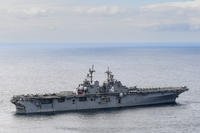 The Air Force is in the early stages of engineering a new class of tailorable, flexible weapons designed to embrace new technologies as they emerge and switch seekers or sensors as needed, service officials said.
The Air Force is in the early stages of engineering a new class of tailorable, flexible weapons designed to embrace new technologies as they emerge and switch seekers or sensors as needed, service officials said.
Managed in part by the Air Force Research Lab Munitions Directorate, the flexible weapons program aims to build small, medium and large-sized bombs able to accommodate the latest in emerging technologies and exchange capabilities, Air Force Chief Scientist Mica Endsley told Military.com in an interview.
“This is a great example of how we are looking at open architecture. As you develop new capabilities, it is easy to swap those onto the aircraft system without having to go through huge changes and costs,” said Endsley.
By open architecture, Endsley was referring to an effort to build weapons able to switch parts as needed, integrate new software and other technologies as they emerge.
The ability to build upon and not limit capability is a major thrust of the flexible weapons program. For instance, the weapons program will be configured to bring the capabilities of GBU-28 bunker busters, precision-guided Joint Direct Attack Munitions and the Small Diameter Bomb II, which is in development. The guided, air-dropped Small Diameter Bomb II can track targets using an RF seeker, millimeter wave technology and semi-active laser guidance.
These modular weapons are slated for development in what’s called a “proof of concept” from 2014 to 2017, said Leo Rose, Air Force Research Laboratory flexible weapon research program manager.
“We want to use inexpensive weapons for inexpensive targets and use more capable weapons for higher-value targets,” he said.
“If I want to do a modular weapon, then one day I put on an EO/IR (electro-optical/infrared) seeker and the weapon works. Then the next day I put an RF seeker on. There are things I have to do from a technology perspective that enable me to do that,” Rose told Military.com.
The effort involves configuring weapons and the systems they include such as sensors, seekers, control modules, ordnance packages, propulsion system and control actuation systems, Rose explained.
“We want a backbone that connects major components together. We’re looking at changing our acquisition philosophy so that we can take advantage of the technologies in the platform and make it easier to do technology refresh,” he added.
For example if a new processor, software or seeker becomes available, the flexible weapons program is being designed to integrate that seamlessly by creating common interfaces at the beginning of the developmental process, Rose said.
“If we’re going to introduce a new approach to the design of a weapon, we certainly are not going to go backwards in capability,” he explained.
The Air Force Research Lab is working to conduct the research needed to reduce the technological risk involved in the flexible weapons acquisition plan. The idea is to streamline technological development, lower risk and significantly reduce costs, Rose explained.
“This is a paradigm shift regarding how we approach the business of developing and procuring weapons. Weapons systems are becoming more expensive and the cost of integrating new technologies on weapons platforms is cost prohibitive.”








